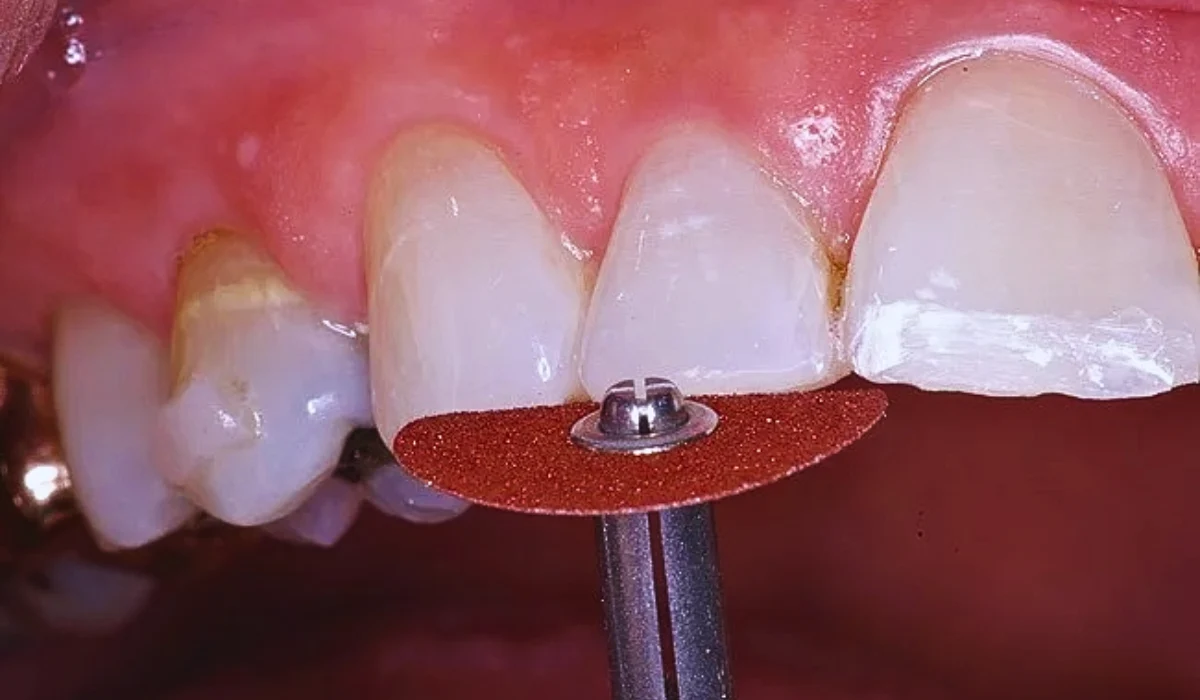Enameloplasty, or tooth reshaping, is a common cosmetic dentistry procedure that involves altering the shape of teeth to improve their appearance. Tooth enamel is the hard, outer surface of the tooth that protects the sensitive inner structures.
Enameloplasty carefully sculpts and contours this enamel layer to smooth chips, fix uneven edges, or change the length, shape, or width of teeth. This tooth reshaping procedure is an economical and conservative way to enhance your smile without more invasive treatments.
As a type of cosmetic dentistry, enameloplasty is primarily aimed at upgrading the aesthetics of your teeth and smile. It can mask visible imperfections or mismatches between teeth to give a more uniform, bright smile. Enameloplasty is performed by a dentist who will assess your smile’s current condition and work with you to determine desired changes. The tooth enamel is then precisely trimmed and shaped using specialty dental tools to sculpt an improved smile.
As tooth enamel does not contain nerves, this reshaping procedure is minimally invasive and generally painless, requiring only local anesthetic in some cases. Continue reading to learn more about what is involved in an enameloplasty procedure, its benefits and limitations, costs, and what to expect during recovery.
What Does The Enameloplasty Procedure Involve?
Enameloplasty is a common and relatively simple cosmetic dentistry procedure. It involves removing or contouring tooth enamel, the hard, outer layer of a tooth, to improve the appearance of teeth that are chipped, uneven, or otherwise misshapen.

The goal of tooth reshaping is to create an aesthetic smile line that showcases straight, symmetrical teeth. Enameloplasty can adjust the shape, length, or position of the teeth for a revitalized smile. This cosmetic procedure is minimally invasive since enamel does not contain nerves and can be safely altered without pain or sensitivity.
Before beginning enameloplasty, your dentist will evaluate your teeth both visually and using intraoral photography. Digital images allow the dentist to highlight problem areas and map out the necessary transformations.
Computer imaging may also generate simulated pictures of what your new smile could look like after the tooth reshaping procedure. This allows you to provide input so your preferences are incorporated into the treatment plan.
The actual tooth reshaping procedure takes place in the dental office. Typically, a local anesthetic gel is applied to the gums surrounding the treatment area. Then your dentist uses a grinding tool or dental drill to buff away uneven edges or layers of enamel.
This sculpts and evens out the tooth surface for a uniform shape and size within your smile. Smoothing rough spots or filling in gaps helps properly align teeth next to each other along the gum line as well. The precision tools remove very thin layers at a time, allowing the dentist to incrementally achieve the desired effects.
After contouring and sculpting the teeth to aesthetic proportions, the tooth enamel may be polished to remove any remaining roughness on the chewing surfaces or along gum lines. Polishing also enhances the shine and luster of the reshaped teeth. The result is a brightened, realigned smile line with balanced, uniform teeth.
Depending on the extent of reshaping needed, enameloplasty treatment may require just a single dental visit. More complex cases could involve two to four appointments over weeks. Maintaining routine dental visits allows your dentist to monitor changes in your bite or the remainder of your oral health over time after the tooth reshaping procedure.
Benefits And Advantages Of Enameloplasty Treatment
Enameloplasty offers a conservative means of enhancing and upgrading your smile’s appearance without more invasive treatments.
Benefits of tooth reshaping include:
- Little to no tooth sensitivity or pain during or after the contouring procedure since enamel lacks nerves (cosmetic dentistry)
- No need for anesthesia beyond local numbing gels applied directly to the reshaped teeth
- Contact with other teeth or chewing forces pose no discomfort after contouring enamel
- Quick recovery without notable restrictions on eating or other oral activities
- More affordable and faster results than treatments like veneers or braces
- Reshaping and recontouring can be repeated in the future if desired to modify or touch up the smile appearance
- Sparing of tooth structure compared to alternatives like dental bonding that require drilling under healthy enamel to anchor restorations
In addition to smoothing over chips and irregularities, some common improvements achievable through skilled tooth reshaping include:
- Closing subtle gaps between teeth to reduce spaces or openings along the gum line
- Resizing teeth to uniform dimensions for a consistent, balanced smile line
- Shortening longer teeth that protrude or extend unevenly beyond others
- Realigning slightly crooked or overlapped teeth by evening their edges
- Shaping a rounder contour on sharp, angular teeth
Thanks to advanced techniques and dental tools, today’s tooth reshaping procedures allow dentists to make precision changes to tooth position and angles. This supports subtle straightening and realignment without full orthodontic treatment.
In some cases, tooth reshaping serves as preparation for further cosmetic treatments down the road, such as dental veneers.
Enameloplasty can optimize the shape of teeth before the application of thin veneer coverings to enhance strength and achieve maximum cosmetic uniformity across your smile. This combination of tooth contouring followed by veneers enables truly dramatic smile makeovers.
Limitations and Considerations of Tooth Reshaping Procedures
While enameloplasty offers faster, more affordable smile upgrades than leading alternatives, some limitations affect its suitability and longevity. Consider the following factors when deciding if tooth reshaping meets your cosmetic goals:
- Amount of enamel available – Excessive trimming and contouring can overly weaken tooth structure and negatively impact function
- Precision level possible – Reshaping cannot produce as uniform or flawless results as custom veneers or crowns
- Durability and longevity – Unlike dental restorations, reshaped teeth remain vulnerable to new chips and cracks over time which may require touch-up adjustments
Typically, at least 50% of healthy tooth enamel must be preserved to maintain sufficient structural integrity and chewing capacity after reshaping procedures. Attempting overly aggressive tooth size reductions or structural adjustments during contouring poses risks like fractures under biting forces over time. This could necessitate more involved restorations later to rebuild and protect the damaged teeth.
The level of correction possible also has limits depending on the starting tooth alignment and bite configuration. For mild to moderate misalignments or irregularities in otherwise healthy teeth, precision enameloplasty adjustments can greatly boost appearance. However, extensive crookedness or overlap issues may require orthodontics and cannot be fully resolved through enamel removal alone.
Over time, the cared-for but exposed enamel of reshaped teeth stays vulnerable to new chips, cracks, or signs of wear. Some patients opt to have tooth contouring redone after a decade or so if their smile loses aesthetic uniformity.
Others eventually move on to dental veneers or other restorations to increase the protection and longevity of a uniformly aligned smile achieved through well-executed tooth reshaping earlier on.
Evaluating options alongside a cosmetic dentist allows you to make an informed decision based on your budget, lifestyle, and goals for upgrading smile aesthetics both near and long term. For the right candidates, enameloplasty offers a minimally invasive way to balance, straighten, brighten, and boost your smile’s appearance and self-confidence.
Also Read: How To Prevent Receding Gums? Causes And Treatments!
Conclusion
Enameloplasty is the dental procedure of choice for conservatively enhancing the aesthetics of your smile. Also called tooth reshaping or contouring, controlled trimming and sculpting of outer tooth enamel can eliminate chips or irregularities, size teeth to uniform dimensions, close subtle gaps, and subtly adjust angles to improve alignment.
This cosmetic treatment requires no drilling or anesthesia, causes no pain or sensitivity, preserves healthy tooth structure, and boasts a quick recovery.
However, tooth reshaping capabilities cannot match the extensive repairs or precise realignment possible with some orthodontic and prosthetic treatments over the long term. Still, when performed skillfully with proper candidate selection, enameloplasty offers faster, affordable smile upgrades using your natural teeth as the foundation.
During your cosmetic dentistry consultation, ask your dentist, “Could tooth reshaping procedures help enhance my smile, or should more involved options be considered given the specific goals and conditions involved?” Determining the optimal approach requires an in-depth assessment of your dental anatomy, bite alignment, and both short and long-term aesthetic objectives. From subtle chip repairs to complete smile makeovers, today’s dental teams have an expanding array of options for transforming your smile. Evaluating enameloplasty alongside other leading cosmetic procedures allows you to make the most empowered decision.

